A Private Tour today, in North Norfolk. The weather was good – sunny and warm in the morning, clouding over in the afternoon but still staying dry until after dark. A great day to be out. We met in Wells and headed east along the coast.
Our first stop this morning was at Stiffkey Fen. As we made our way down along the footpath, a Marsh Harrier flew low over the field beside us. Through binoculars, we could see it was carrying green wing tags, but it was too far away for us to read the all-important code on them. It hung in the air or a second over the trees and was joined by second Marsh Harrier, this time a dark chocolate brown juvenile. As we continued along the path, a Green Woodpecker flew over the field and disappeared across the path behind us.
In the trees down by the river, a couple of Chiffchaffs were calling. We could hear a flock of Long-tailed Tits coming, and as we came out of the trees we found a mixed tit flock moving ahead of us. In with the tits were several Blackcaps and a single Reed Warbler too, feeding high up in the sallows. As we walked on along the path, we flushed a good number of Greenfinches from the brambles, where they were feeding on the blackberries, along with a couple of Chaffinches and Goldfinches. A small number of lingering House Martins were still fluttering around the eaves of the house on the hill and a Mistle Thrush over.
The vegetation is tall along here now, so it is hard to see much of the Fen from the path. However, through a gap in the trees we could make out a long line of large white shapes over towards one side, amongst all the geese. A big group of Spoonbills. There is a better view from up on the seawall and now we could see them properly and count them – 39 in total, all in one group.
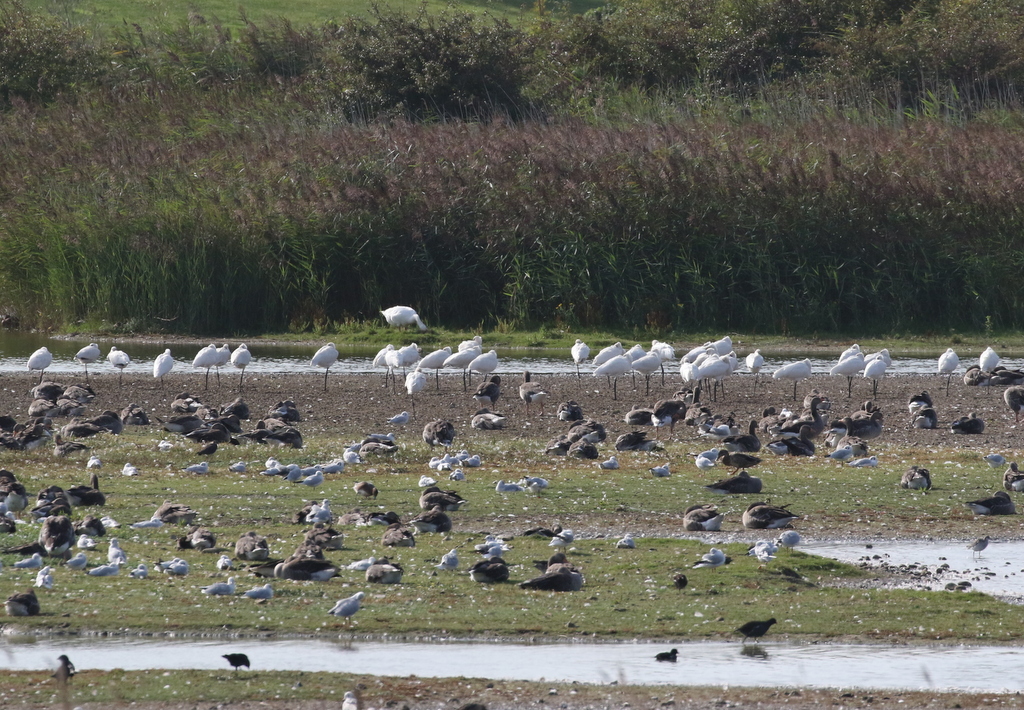 Spoonbills – 39 in one flock, out on Stiffkey Fen, all asleep!
Spoonbills – 39 in one flock, out on Stiffkey Fen, all asleep!
The Spoonbills were doing what Spoonbills like to do best – sleeping! Just occasionally one would lift its head briefly, but it was still great to see so many together like this, the product of a productive breeding season here this summer.
On the way out, we had heard the distinctive ringing call of Greenshanks. We found them in one corner of the Fen, a flock of 24 of them roosting together. They come in to here from the muddy channels out on the saltmarsh to roost over high tide. There was a big flock of Redshank too, closer to us, just beyond the reeds. The tide was already going out fast and first the Redshanks started heading back out, calling noisily. Several of them dropped down onto the mud beside the harbour channel just beyond the seawall and they were joined by a single Greenshank, giving us a great comparison side by side through the scope.
There were also lots of Black-tailed Godwit asleep here, roosting on the Fen, but they seemed to be showing no inclination to head back out to the harbour. Several Ruff were picking around the islands among the masses of Greylag Geese and ducks. There were plenty of Mallard and a few Gadwall, but numbers of Teal are starting to increase as well now as birds return for the winter and we found a handful of Wigeon in amongst them too.
It was already looking like a good day for raptors. A Hobby flew in low and fast over the saltmarsh and zipped away inland across the field just beyond the Fen. Then we looked up to see seven Common Buzzards circling in the sunshine. They were trying to make their way west, but turned to head out over the edge of the saltmarsh, looking for thermals. There were clearly a few Common Buzzards on the move today, as these would not be the only ones we saw.
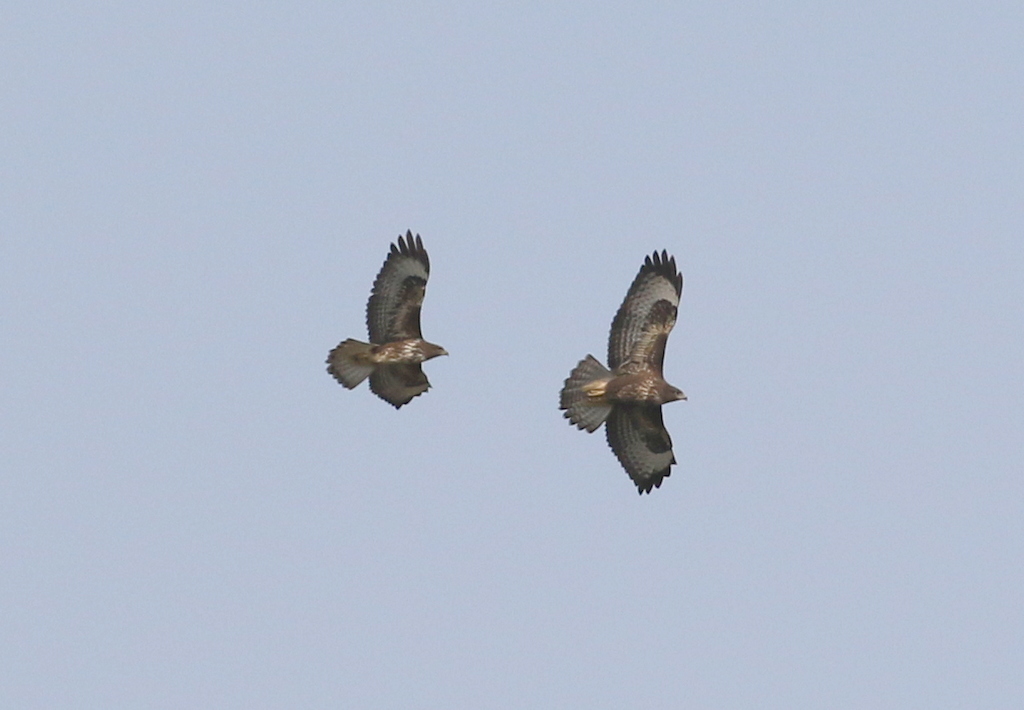 Common Buzzards – 2 of the 7 which circled west this morning
Common Buzzards – 2 of the 7 which circled west this morning
Continuing along the path out towards the harbour, a small group of Meadow Pipits flew over calling, also on the move today, heading west. A female Yellowhammer which flew off calling from the top of the hedge was most likely a local bird.
Out in the harbour, the number of waders is increasing steadily now. With the tide going out fast, they were starting to spread out across the mud. We could see lots of black and white Oystercatchers and several Curlew. A cracking Grey Plover still in full breeding plumage caught our attention, with jet black face and belly surrounded in gleaming white. Stunning. There were lots more Grey Plover further out on the mud, in various different stages of moult to greyer winter plumage.
There were several Black-tailed Godwits feeding out on the mud now, and in with them we could see several smaller waders. The larger, dumpier, greyer ones were Knot, the smaller ones were Dunlin. A Ringed Plover stood out with its black and white ringed head. A single Bar-tailed Godwit was further out on the mud.
As we turned to walk back, a Stonechat appeared on a low Suaeda bush next to the path. It flicked across to the other side and then more Stonechats appeared following it, there was clearly a little group of them. They didn’t appear to be a family party, so most likely this was a small post-breeding group which you sometimes get at this time of year. After they had gone, we flushed a Whitethroat which was skulking in the vegetation by the path.
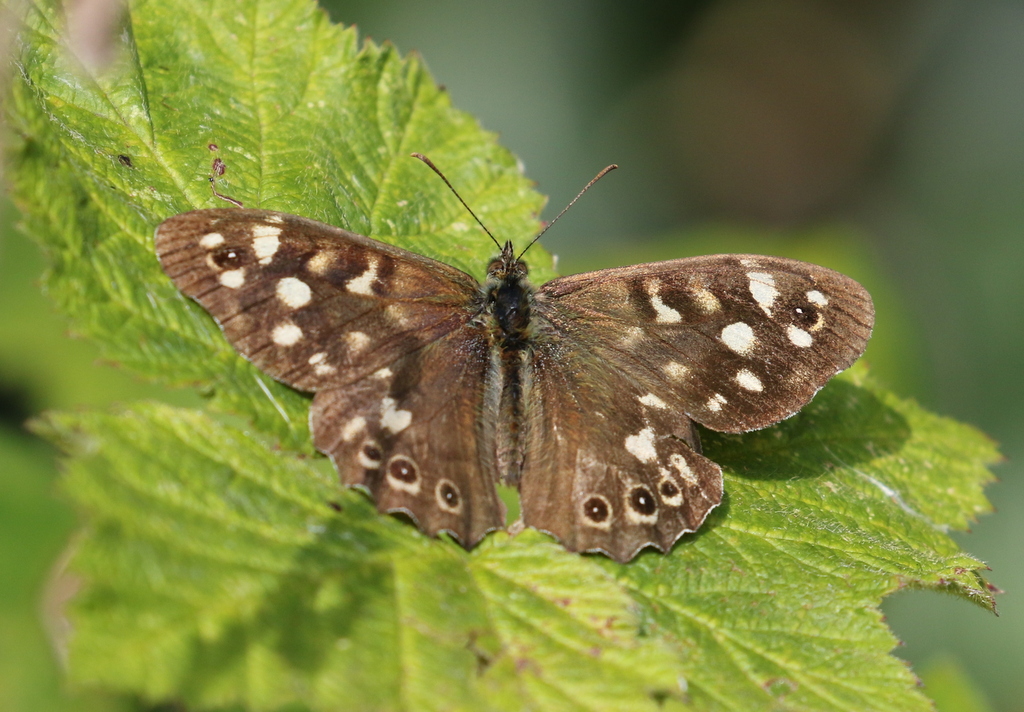 Speckled Wood – there were several out in the sunshine this morning
Speckled Wood – there were several out in the sunshine this morning
On the way back, there were several insects out enjoying the sunshine. We saw several Speckled Wood butterflies and a nice selection of dragonflies – Migrant Hawker, plus Common Darter and Ruddy Darter. We picked up the tit flock again, in the sallows by the path, and while we were following them we heard a couple of Bullfinches calling plaintively, getting a brief glimpse of them as they flew across overhead. A Cetti’s Warbler sang rather half-heartedly from the river bank. singing. Then back at the car, we stopped to look at the Stock Doves with the Woodpigeons in the field beside us. The metallic green neck patch on the one we got in the scope was really shining in the sun.
Our next destination was Cley. We still had a bit of time before lunch, so we made our way round to the beach car park. On our way there, a Wheatear flicked across the road right in front of the car, flashing its white rump. It landed on the West Bank right beside us, so we stopped to get a closer look at it. But another car pulled up right behind us and they were impatient, clearly in a great hurry to get to the car park beyond, and honked their horn. The Wheatear promptly flew off. We drove into the car park and stopped, and as we got out we saw the car behind in discussion with the attendant. Presumably they didn’t want to pay, as they turned round and headed back up Beach Road. So much for them being in such a hurry to get here!
We headed out along the beach towards North Scrape. Thankfully there were several more Wheatears on the fence posts along here, so we got a chance to stop and look at them at our leisure. Smart birds, autumn migrants stopping off to feed on their way south. There was no sign of any of the Whinchat with them though, which had been reported earlier. A Green Sandpiper was calling incessantly out on Billy’s Wash, but we couldn’t see it from the path.
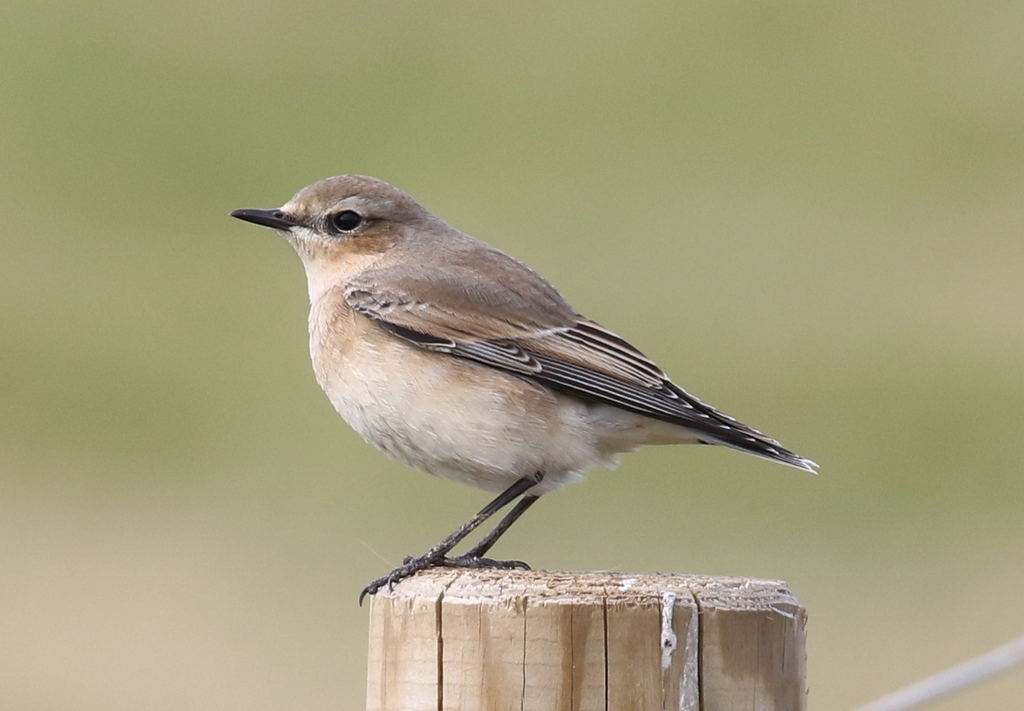 Wheatear – one of several along the Eye Field fence today
Wheatear – one of several along the Eye Field fence today
Out at North Scrape, yet another Wheatear was perched obligingly on the reed screen, reluctant to leave the area of strimmed grass where it had presumably been feeding. There seemed to be lots of water on the scrape and didn’t look to be much of note on there at first, mostly a few ducks, Teal, Shoveler and Shelduck.
There was the grand total of five waders on the edge of the nearest island so we had a quick look at them. A juvenile Ruff and two Redshank were predictable enough, but the two smaller ones turned out to be a Curlew Sandpiper with a lone Dunlin. The Curlew Sandpiper was a juvenile, with a peachy orange wash across the breast and scaly back. We got a good view through the scope, at one point the two of them were feeding together, the Curlew Sandpiper noticeably bigger and with a longer, more down-curved bill.
 Curlew Sandpiper – a juvenile on North Scrape
Curlew Sandpiper – a juvenile on North Scrape
A real long distance migrant, it was remarkable to think that this Curlew Sandpiper had stopped off here to feed on its way from arctic Siberia, where it was raised over the summer, to Africa for the winter.
As we got up to walk back, we could see someone photographing the Wheatears along the fence line back towards the car park. Just beyond, we could see another smaller bird perched on the fence. Through the scope we confirmed that it was the Whinchat. We had a quick look from here, then hurried back along the path before it might be flushed. The photographer was so focused on one of the Wheatears that she hadn’t seen it. Thankfully it was still there when we got there and we got a good look at it through the scope.
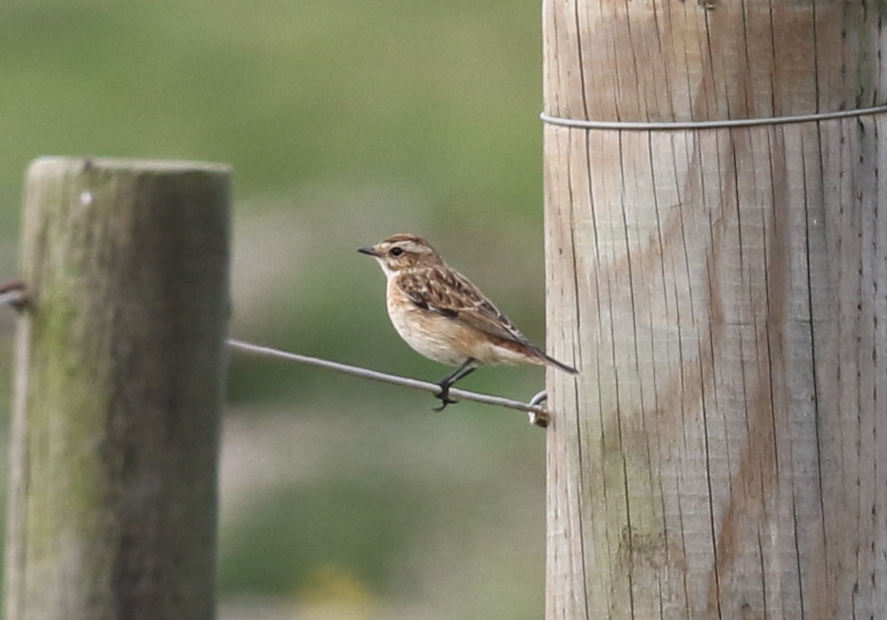 Whinchat – had reappeared on the fence on our way back
Whinchat – had reappeared on the fence on our way back
The Whinchat was more strongly marked than the Wheatears, patterned brown and black on the upperparts and with a noticeable pale supercilium. It dropped down from the fence and flew into the field, where it perched on a dead dock seedhead for a while, scanning the ground below for insects, occasionally dropping down into the grass. Eventually it moved further out into the field and was lost to view. As well as more Wheatears, we flushed several Meadow Pipits and Linnets from the vegetation on the shingle on the walk back.
After lunch back at the visitor centre, we headed out to the hides. There was a nice selection of waders on Simmond’s Scrape. Several Black-tailed Godwit and Ruff were feeding down at the front, giving us better views than we had had of them earlier. A couple of Common Snipe were hiding down in the wet grass on the edge of the scrape, only really visible when they ran up and across the bank, striking birds with their long bills and golden stripes.
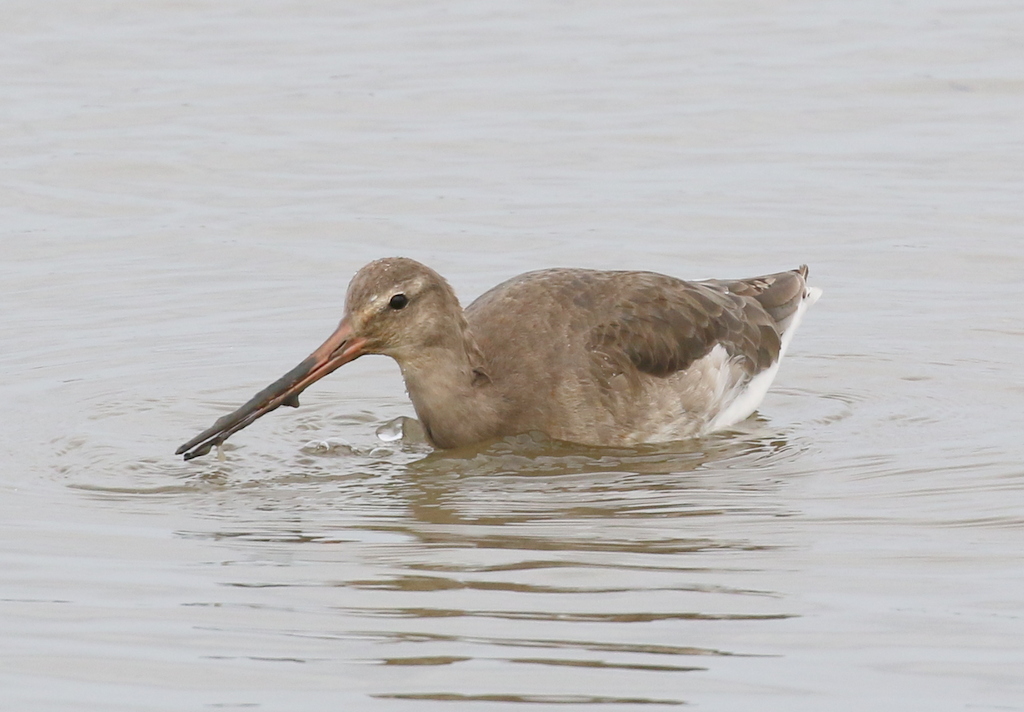 Black-tailed Godwit – feeding down at the front of the scrape
Black-tailed Godwit – feeding down at the front of the scrape
Further back, two Knot were busily feeding on the wet mud with a small flock of Dunlin. A Common Sandpiper was feeding along the back edge of the scrape, bobbing up and down as it worked its way along the edge of the grass. We could hear another Green Sandpiper and looked out of the side of the hide to see it on the edge of the water out behind Whitwell Scrape. A Greenshank flew past calling.
There were two more Spoonbills here on the scrape. One was asleep, just like the birds we had seen earlier, but a juvenile Spoonbill was walking round on island, pecking at the mud. It seemed like it had not got the hang of feeding yet – it should be in the water! But at least we could see its distinctive spoon-shaped bill, plain fleshy brown on a juvenile.
A few Black-headed Gulls were dotted around the scrape, now in winter plumage and lacking their summer brown heads. Further over were three larger gulls and one of them caught our attention. It was smaller than the two Great Black-backed Gulls it was with, and we could see that although it was obviously a young bird, juvenile/1st winter or 1st calendar year, it already had a strikingly pale whitish head. It was hard to see properly at first, hiding behind the larger gulls, but eventually it came out and our suspicions were confirmed, it was a Caspian Gull.
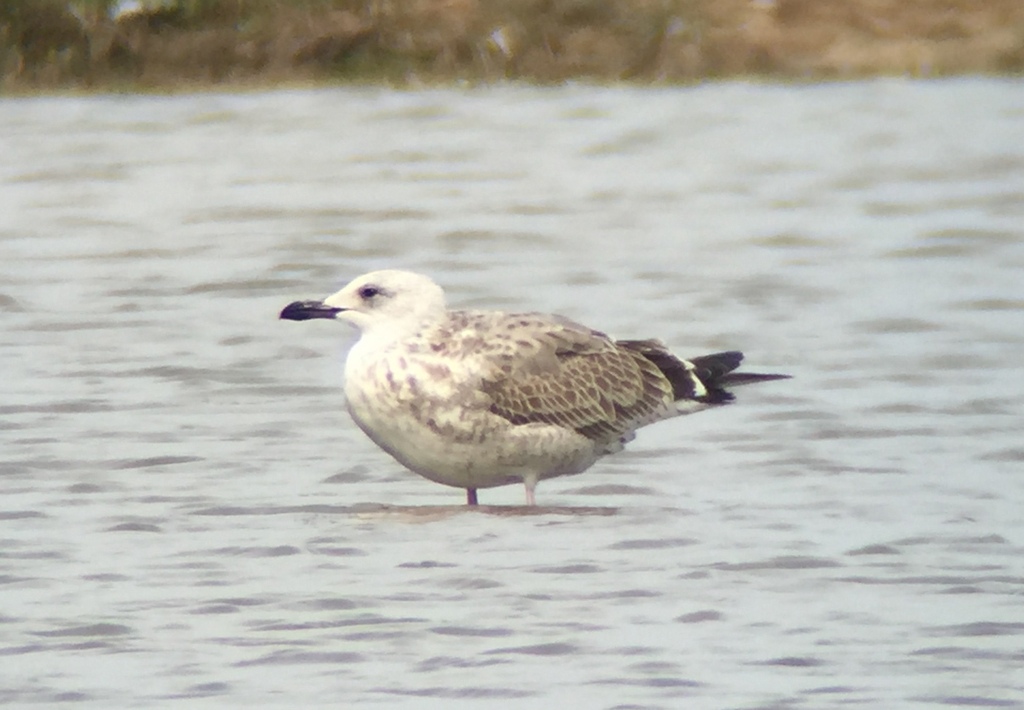 Caspian Gull – appeared briefly on the scrape
Caspian Gull – appeared briefly on the scrape
After a good look at the Caspian Gull through the scope, we discussed some of the finer identification points with the benefit of some photos. The rather solid grey-brown wing coverts with neat pale edges and contrasting dark tertials with bright white ‘thumbnail’ tips are all juvenile feathers. It has already moulted its mantle extensively, with lots of new and rather plain grey 1st winter feathers. Caspian Gulls are regular here at this time of the year, but they are mostly seen coming in very late in the evening on their way to roost, so it was great to see one so well in the middle of the afternoon.
At that point, everything flushed and scattered as a Hobby appeared overhead. It was joined by a second Hobby, the two of them buzzing the scrapes, scything through the startled birds. One of them stooped at an unsuspecting Dunlin, the latter successfully taking evasive action as the Hobby turned and climbed again sharply. They made a pass or two right in front of the hide, giving us stunning close up views.
 Hobby – one of two which started buzzing the scrapes
Hobby – one of two which started buzzing the scrapes
Then two Marsh Harriers joined in, circling out over the scrape, possibly hoping to take advantage of the general pandemonium. The two Hobbys started to mob the Marsh Harriers, stooping at them, trying to drive them back to the reedbed. It was real all-action stuff! We didn’t know where to look.
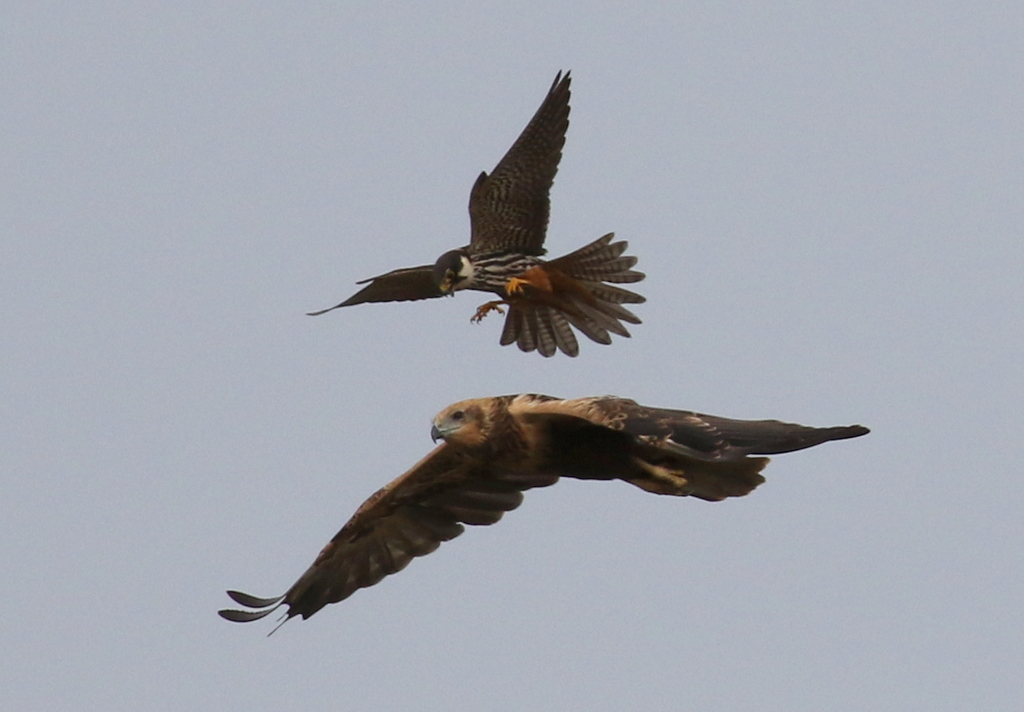
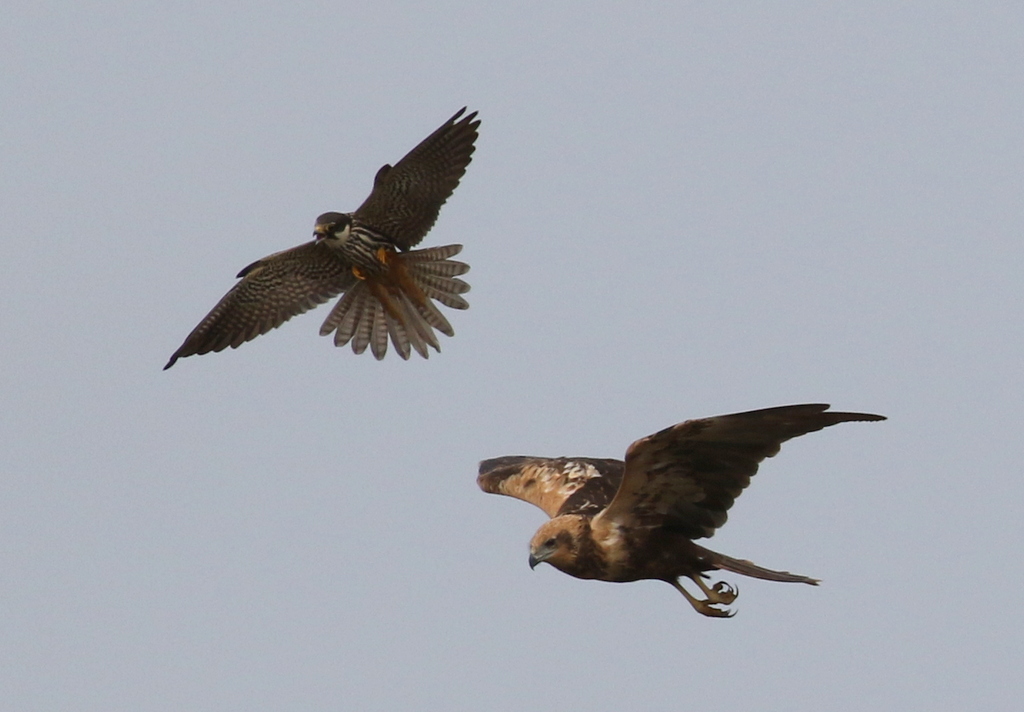 Hobby – mobbing one of the local Marsh Harriers
Hobby – mobbing one of the local Marsh Harriers
Eventually, the Hobbys gave up and moved on. As things started to settle down again, four more Common Buzzards circled over the reeds and drifted off west over the hide. The Spoonbills had taken off too, even the adult which had been sleeping almost constantly since we arrived had woken up. They circled round and landed in front of the hide, on the edge of the nearest island, giving us a great view now. We could see the adult Spoonbill’s black bill with distinctive yellow tip, very different from the juvenile’s fleshy bill.
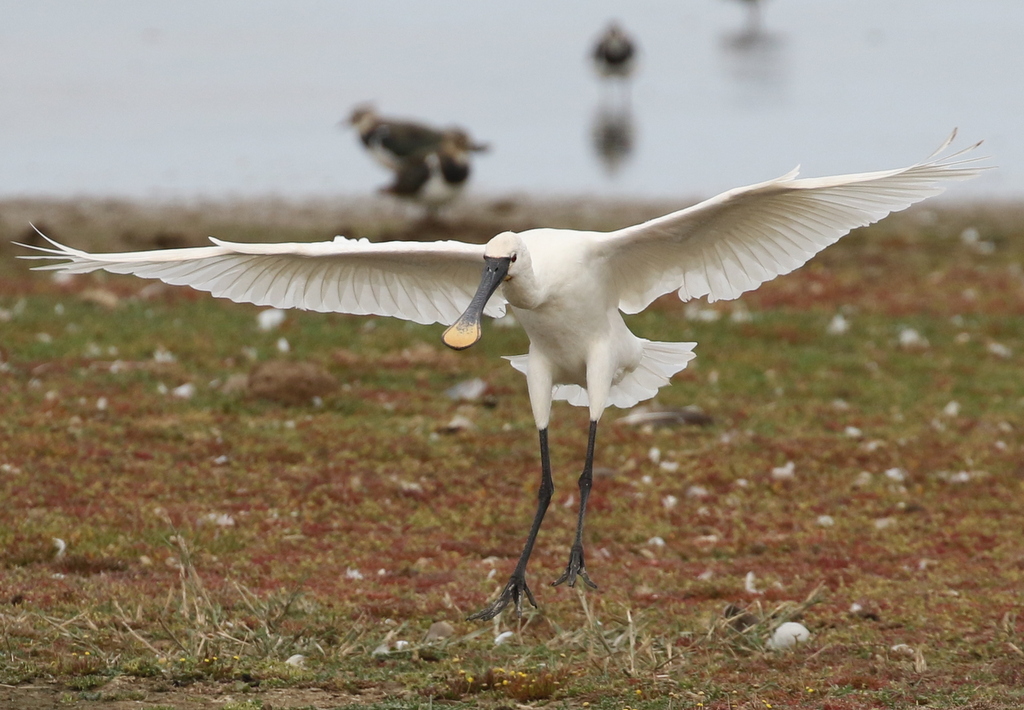 Spoonbill – the adult coming into land, flashing its yellow bill tip
Spoonbill – the adult coming into land, flashing its yellow bill tip
Most of the small waders had cleared out after the Hobbys and Marsh Harriers had done their stuff. We walked round to Teal Hide and had a quick look on Pat’s Pool. The Black-tailed Godwits, Ruff and Lapwing had all settled back down onto the scrape, but other than that there were just a couple of Dunlin and a single Ringed Plover left on here.
After walking back to the car, we headed out to East Bank. A single Sand Martin flew past over the reeds – numbers of hirundines are steadily dropping now as birds head off south already. Apart from a large gaggle of Greylags and Canada Geese, we could see a few Lapwing down in the grass with several moulting juvenile Starlings in amongst them. A Ruff and a Common Snipe were hiding down on the edge of one of the small pools. Four Avocets were busy feeding, up to their bellies out on the Serpentine.
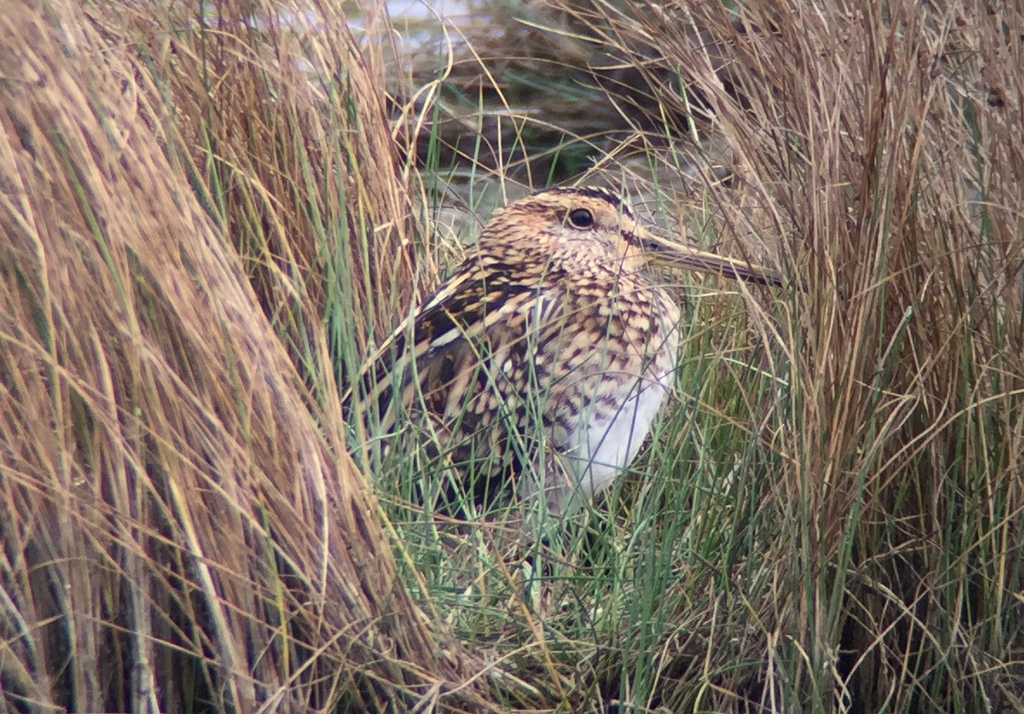 Common Snipe – hiding in the grass on Pope’s Marsh
Common Snipe – hiding in the grass on Pope’s Marsh
Further over, on Pope’s Pool, there were lots of Teal and Redshank. Looking through them carefully, we found a single Spotted Redshank too, paler silvery grey above and white below compared to the Common Redshanks. Its feeding action stood out too, walking around in circles with its long bill down in the water, sweeping it from side to side.
The biggest surprise of the day came when we were scanning the grazing marsh to the east of the East Bank. We picked up a tight flock of small birds flying directly towards us low over the grass. As they flew up and over the bank we could see they were Tree Sparrows, eight of them. They used to be common birds, but Tree Sparrows are now very scarce here, victims of agricultural intensification. Back in the 1970s, counts of migrating Tree Sparrows numbering in the hundreds were not unknown on some days on the coast, but sadly this is now a thing of the past and only very small numbers are seen these days on passage.
The Tree Sparrows continued on strongly west over the reedbed the other side of the path. There were a few more Meadow Pipits flying west too, more birds on the move already. Further along, we heard a Bearded Tit calling, and turned to catch a glimpse as one flew across, skimming the top of the reeds. Despite more calling, we didn’t see another one, but it was rather breezy up here this afternoon.
Out at Arnold’s Marsh, there were several Cormorants standing around or dying their wings around the island at the back. A good number of Black-tailed Godwit on here were mostly asleep, although one rather rusty bird, still sporting quite a bit of bright summer plumage, drew attention to itself. Otherwise, there were several Curlew and a plenty of Redshanks here. A Brown Hare on one of the vegetated shingle spits was quite hard to see, its black tipped ears more visible through the scope.
Even though it was cloudy, we stood and admired the view, looking out east across the marshes towards the cliffs at Weybourne and Sheringham. The saltmarsh vegetation, samhpire and sea lavender, was striped in various autumnal shades of orange and red.
 Arnold’s Marsh – looking east towards Weybourne & Sheringham
Arnold’s Marsh – looking east towards Weybourne & Sheringham
As we walked on towards the beach, several Little Egrets were flying around or preening on the edge of the pools. We talked about how this used to be a rare bird here in UK, so at least some things are doing well, while others like Tree Sparrow seem in unstoppable decline. Six Wigeon flew in off the sea and dropped down towards North Scrape, presumably freshly arrived from their breeding grounds in Russia for the winter.
Out at the beach, the sea was calm and quiet. A Fulmar circled offshore. A small group of four Ringed Plover flew west along the shoreline, yet more birds on the move today. The migration season is certainly well underway now. Unfortunately, at this stage, it was time to call it a day and head for home. It had been a great day though, with lots of action and different things to see, plenty of memorable moments.
















